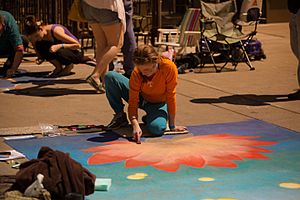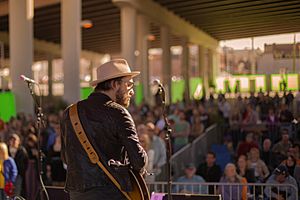Dogwood Arts Festival facts for kids
The Dogwood Arts Festival is a super fun yearly event in Knoxville, Tennessee. It's put on by Dogwood Arts, a group that helps share and celebrate local art, culture, and nature's beauty. This festival happens every April. It celebrates when the beautiful dogwood trees bloom.
The festival has many cool activities. You can see a parade and visit house and garden shows. There are also demonstrations of traditional Appalachian arts. These include quilting, bluegrass music, and doll-making. Many events take place in Market Square in downtown Knoxville. You can also drive along special trails to see dogwood trees blooming all over the city.
How the Festival Started
The idea for the Dogwood Arts Festival began in the 1950s. A writer named John Gunther visited Knoxville in 1947. He wrote in his book Inside U.S.A. that Knoxville was the "ugliest city" in the United States. This made the people of Knoxville feel a bit sad.
In response, leaders in Knoxville decided to make their city more beautiful. They started by cleaning up yards and neighborhoods. In 1955, the first special "dogwood trail" was created. This trail was in the Sequoyah Hills area. More trails were added in other neighborhoods later on.
In 1959, a newspaper writer named Carson Brewer suggested a dogwood festival. He thought it could be as successful as other local festivals. The city's chamber of commerce and the Junior League loved the idea. They each gave money to help make it happen. This led to the very first annual festival in 1961.
Festival's Impact and Growth
Over the years, the festival helped Knoxville become known for its beauty. In 1995, a famous journalist named Paul Harvey praised the city. He said Knoxville was a "springtime blizzard of blossoms of dogwood." He noted that many other flowers also bloomed during the festival. These included violets, iris, lilacs, and narcissus. He mentioned that the festival attracted many visitors each year.
In 2020, something different happened. Due to the COVID-19 pandemic, most events were canceled. For the first time in its history, the festival went online. People could still enjoy some parts of it virtually.
Images for kids







